 W
WIn chemistry, thermodynamics, and many other related fields, phase transitions are the physical processes of transition between the basic states of matter: solid, liquid, and gas, as well as plasma in rare cases.
 W
WThe Abelian sandpile model, also known as the Bak–Tang–Wiesenfeld model, was the first discovered example of a dynamical system displaying self-organized criticality. It was introduced by Per Bak, Chao Tang and Kurt Wiesenfeld in a 1987 paper.
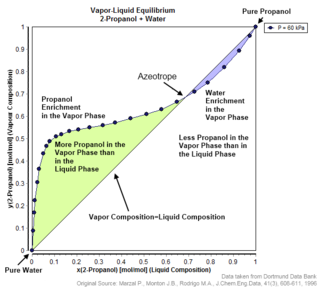 W
WAn azeotropes or a constant boiling point mixture is a mixture of two or more liquids whose proportions cannot be altered or changed by simple distillation. This happens because when an azeotrope is boiled, the vapour has the same proportions of constituents as the unboiled mixture. Because their composition is unchanged by distillation, azeotropes are also called constant boiling point mixtures.
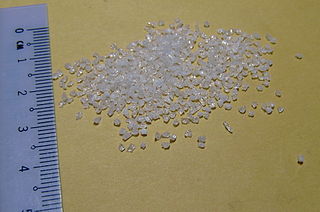 W
WA boiling chip, boiling stone, porous bit or anti-bumping granule is a tiny, unevenly shaped piece of substance added to liquids to make them boil more calmly. Boiling chips are frequently employed in distillation and heating. When a liquid becomes superheated, a speck of dust or a stirring rod can cause violent flash boiling. Boiling chips provide nucleation sites so the liquid boils smoothly without becoming superheated or bumping.
 W
WIn thermodynamics, the bubble point is the temperature where the first bubble of vapor is formed when heating a liquid consisting of two or more components. Given that vapor will probably have a different composition than the liquid, the bubble point at different compositions are useful data when designing distillation systems.
 W
WIn physics, a "coffee ring" is a pattern left by a puddle of particle-laden liquid after it evaporates. The phenomenon is named for the characteristic ring-like deposit along the perimeter of a spill of coffee. It is also commonly seen after spilling red wine. The mechanism behind the formation of these and similar rings is known as the coffee ring effect or in some instances, the coffee stain effect, or simply ring stain.
 W
WCondensation is the change of the physical state of matter from the gas phase into the liquid phase, and is the reverse of vaporization. The word most often refers to the water cycle. It can also be defined as the change in the state of water vapor to liquid water when in contact with a liquid or solid surface or cloud condensation nuclei within the atmosphere. When the transition happens from the gaseous phase into the solid phase directly, the change is called deposition.
 W
WCongruent melting occurs during melting of a compound when the composition of the liquid that forms is the same as the composition of the solid. It can be contrasted with incongruent melting. This generally happens in two-component systems. To take a general case, let A and B be the two components and AB a stable solid compound formed by their chemical combination. If we draw a phase diagram for the system, we notice that there are three solid phases, namely A, B and compound AB. Accordingly, there will be three fusion or freezing point curves AC, BE and CDE for the three solid phases. In the phase diagram, we can notice that the top point D of the phase diagram is the congruent melting point of the compound AB because the solid and liquid phases now have the same composition. Evidently, at this temperature, the two-component system has become a one-component system because both solid and liquid phases contains only the compound AB.
 W
WA continuous cooling transformation (CCT) phase diagram is often used when heat treating steel. These diagrams are used to represent which types of phase changes will occur in a material as it is cooled at different rates. These diagrams are often more useful than time-temperature-transformation diagrams because it is more convenient to cool materials at a certain rate, than to cool quickly and hold at a certain temperature.
 W
WCritical opalescence is a phenomenon which arises in the region of a continuous, or second-order, phase transition. Originally reported by Charles Cagniard de la Tour in 1823 in mixtures of alcohol and water, its importance was recognised by Thomas Andrews in 1869 following his experiments on the liquid-gas transition in carbon dioxide, many other examples have been discovered since. The phenomenon is most commonly demonstrated in binary fluid mixtures, such as methanol and cyclohexane. As the critical point is approached, the sizes of the gas and liquid region begin to fluctuate over increasingly large length scales. As the density fluctuations become of a size comparable to the wavelength of light, the light is scattered and causes the normally transparent liquid to appear cloudy. Tellingly, the opalescence does not diminish as one gets closer to the critical point, where the largest fluctuations can reach even centimetre proportions, confirming the physical relevance of smaller fluctuations.
 W
WIn thermodynamics, a critical point is the end point of a phase equilibrium curve. The most prominent example is the liquid–vapor critical point, the end point of the pressure–temperature curve that designates conditions under which a liquid and its vapor can coexist. At higher temperatures, the gas cannot be liquefied by pressure alone. At the critical point, defined by a critical temperature Tc and a critical pressure pc, phase boundaries vanish. Other examples include the liquid–liquid critical points in mixtures.
 W
WA cryophorus is a glass container containing liquid water and water vapor. It is used in physics courses to demonstrate rapid freezing by evaporation. A typical cryophorus has a bulb at one end connected to a tube of the same material. When the liquid water is manipulated into the bulbed end and the other end is submerged into a freezing mixture, the gas pressure drops as it is cooled. The liquid water begins to evaporate, producing more water vapor. Evaporation causes the water to cool rapidly to its freezing point and it solidifies suddenly.
 W
WCrystallization or crystallisation is the process by which a solid forms, where the atoms or molecules are highly organized into a structure known as a crystal. Some of the ways by which crystals form are precipitating from a solution, freezing, or more rarely deposition directly from a gas. Attributes of the resulting crystal depend largely on factors such as temperature, air pressure, and in the case of liquid crystals, time of fluid evaporation.
 W
WIn physics and materials science, the Curie temperature (TC), or Curie point, is the temperature above which certain materials lose their permanent magnetic properties, which can be replaced by induced magnetism. The Curie temperature is named after Pierre Curie, who showed that magnetism was lost at a critical temperature.
 W
WDeposition is the phase transition in which gas transforms into solid without passing through the liquid phase. Deposition is a thermodynamic process. The reverse of deposition is sublimation and hence sometimes deposition is called desublimation.
 W
WA phase diagram in physical chemistry, engineering, mineralogy, and materials science is a type of chart used to show conditions at which thermodynamically distinct phases occur and coexist at equilibrium.
 W
WA diffusionless transformation is a phase change that occurs without the long-range diffusion of atoms but rather by some form of cooperative, homogeneous movement of many atoms that results in a change in crystal structure. These movements are small, usually less than the interatomic distances, and the atoms maintain their relative relationships. The ordered movement of large numbers of atoms leads some to refer to these as military transformations in contrast to civilian diffusion-based phase changes.
 W
WDistillation is the process of separating the components or substances from a liquid mixture by using selective boiling and condensation. Distillation may result in essentially complete separation, or it may be a partial separation that increases the concentration of selected components in the mixture. In either case, the process exploits differences in the relative volatility of the mixture's components. In industrial applications, distillation is a unit operation of practically universal importance, but it is a physical separation process, not a chemical reaction.
 W
WA eutectic system from the Greek "εύ" and "τήξις" is a homogeneous mixture of substances that melts or solidifies at a single temperature that is lower than the melting point of any of the constituents.
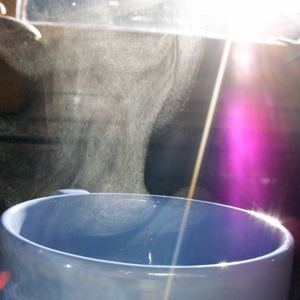 W
WEvaporation is a type of vaporization that occurs on the surface of a liquid as it changes into the gas phase. The surrounding gas must not be saturated with the evaporating substance. When the molecules of the liquid collide, they transfer energy to each other based on how they collide with each other. When a molecule near the surface absorbs enough energy to overcome the vapor pressure, it will escape and enter the surrounding air as a gas. When evaporation occurs, the energy removed from the vaporized liquid will reduce the temperature of the liquid, resulting in evaporative cooling.
 W
WIn chemistry, fractional crystallization is a method of refining substances based on differences in their solubility. It fractionates via differences in crystallization (forming of crystals). If a mixture of two or more substances in solution are allowed to crystallize, for example by allowing the temperature of the solution to decrease or increase, the precipitate will contain more of the least soluble substance. The proportion of components in the precipitate will depend on their solubility products. If the solubility products are very similar, a cascade process will be needed to effectuate a complete separation. This technique is often used in chemical engineering to obtain very pure substances, or to recover saleable products from waste solutions. Fractional crystallization can be used to separate solid-solid mixtures. An example is separating KNO3 and KClO3.
 W
WFractional freezing is a process used in process engineering and chemistry to separate substances with different melting points. It can be done by partial melting of a solid, for example in zone refining of silicon or metals, or by partial crystallization of a liquid, as in freeze distillation, also called normal freezing or progressive freezing. The initial sample is thus fractionated.
 W
WFreezing is a phase transition where a liquid turns into a solid when its temperature is lowered below its freezing point. In accordance with the internationally established definition, freezing means the solidification phase change of a liquid or the liquid content of a substance, usually due to cooling.
 W
WFreezing-point depression is the decrease of the freezing point of a solvent on the addition of a non-volatile solute. Examples include salt in water, alcohol in water, or the mixing of two solids such as impurities into a finely powdered drug. In all cases, the substance added/present in smaller amounts is considered the solute, while the original substance present in larger quantity is thought of as the solvent. The resulting liquid solution or solid-solid mixture has a lower freezing point than the pure solvent or solid because the chemical potential of the solvent in the mixture is lower than that of the pure solvent, the difference between the two being proportional to the natural logarithm of the mole fraction. In a similar manner, the chemical potential of the vapor above the solution is lower than that above a pure solvent, which results in boiling-point elevation. Freezing-point depression is what causes sea water,, to remain liquid at temperatures below 0 °C (32 °F), the freezing point of pure water.
 W
WGas is one of the four fundamental states of matter. A pure gas may be made up of individual atoms, elemental molecules made from one type of atom, or compound molecules made from a variety of atoms. A gas mixture, such as air, contains a variety of pure gases. What distinguishes a gas from liquids and solids is the vast separation of the individual gas particles. This separation usually makes a colorless gas invisible to the human observer. The interaction of gas particles in the presence of electric and gravitational fields are considered negligible, as indicated by the constant velocity vectors in the image.
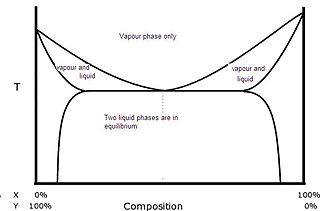 W
WA heteroazeotrope is an azeotrope where the vapour phase coexists with two liquid phases. Sketch of a T-x/y equilibrium curve of a typical heteroazeotropic mixture
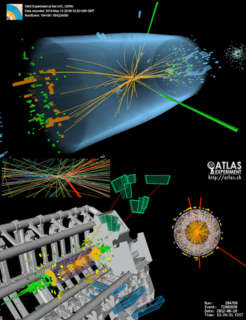 W
WThe Higgs boson is an elementary particle in the Standard Model of particle physics produced by the quantum excitation of the Higgs field, one of the fields in particle physics theory. It is named after physicist Peter Higgs who in 1964 along with five other scientists proposed the Higgs mechanism to explain why some particles have mass.. This mechanism required that a spinless particle known as a boson should exist with properties as described by the Higgs Mechanism theory. This particle was called the Higgs boson. A subatomic particle with the expected properties was discovered in 2012 by the ATLAS and CMS experiments at the Large Hadron Collider (LHC) at CERN near Geneva, Switzerland. The new particle was subsequently confirmed to match the expected properties of a Higgs boson.
 W
WIn the Standard Model of particle physics, the Higgs mechanism is essential to explain the generation mechanism of the property "mass" for gauge bosons. Without the Higgs mechanism, all bosons (one of the two classes of particles, the other being fermions) would be considered massless, but measurements show that the W+, W−, and Z0 bosons actually have relatively large masses of around 80 GeV/c2. The Higgs field resolves this conundrum. The simplest description of the mechanism adds a quantum field (the Higgs field) that permeates all space to the Standard Model. Below some extremely high temperature, the field causes spontaneous symmetry breaking during interactions. The breaking of symmetry triggers the Higgs mechanism, causing the bosons it interacts with to have mass. In the Standard Model, the phrase "Higgs mechanism" refers specifically to the generation of masses for the W±, and Z weak gauge bosons through electroweak symmetry breaking. The Large Hadron Collider at CERN announced results consistent with the Higgs particle on 14 March 2013, making it extremely likely that the field, or one like it, exists, and explaining how the Higgs mechanism takes place in nature.
 W
WIsothermal transformation diagrams are plots of temperature versus time. They are generated from percentage transformation-vs time measurements, and are useful for understanding the transformations of an alloy steel at elevated temperatures.
 W
WJamming is the physical process by which the viscosity of some mesoscopic materials, such as granular materials, glasses, foams, polymers, emulsions, and other complex fluids, increases with increasing particle density. The jamming transition has been proposed as a new type of phase transition, with similarities to a glass transition but very different from the formation of crystalline solids.
 W
WThe latent internal energy of a system is the internal energy a system requires to undergo a phase transition. Its value is specific to the substance or mix of substances in question. The value can also vary with temperature and pressure. Generally speaking the value is different for the type of phase change being accomplished. Examples can include Latent internal energy of vaporization, Latent internal energy of crystallization Latent internal energy of sublimation. These values are usually expressed in units of energy per mole or per mass such as J/mol or BTU/lb. Often a negative sign will be used to represent energy being withdrawn from the system, while a positive value represents energy being added to the system. However, reference sources do vary so check the source to be sure.
 W
WA liquid is a nearly incompressible fluid that conforms to the shape of its container but retains a (nearly) constant volume independent of pressure. As such, it is one of the four fundamental states of matter, and is the only state with a definite volume but no fixed shape. A liquid is made up of tiny vibrating particles of matter, such as atoms, held together by intermolecular bonds. Like a gas, a liquid is able to flow and take the shape of a container. Most liquids resist compression, although others can be compressed. Unlike a gas, a liquid does not disperse to fill every space of a container, and maintains a fairly constant density. A distinctive property of the liquid state is surface tension, leading to wetting phenomena. Water is, by far, the most common liquid on Earth.
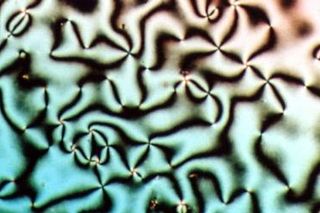 W
WLiquid crystals (LCs) are a state of matter which has properties between those of conventional liquids and those of solid crystals. For instance, a liquid crystal may flow like a liquid, but its molecules may be oriented in a crystal-like way. There are many different types of liquid-crystal phases, which can be distinguished by their different optical properties. The contrasting areas in the textures correspond to domains where the liquid-crystal molecules are oriented in different directions. Within a domain, however, the molecules are well ordered. LC materials may not always be in a liquid-crystal state of matter.
 W
WThe liquidus temperature, TL or Tliq, specifies the temperature above which a material is completely liquid, and the maximum temperature at which crystals can co-exist with the melt in thermodynamic equilibrium. It is mostly used for impure substances (mixtures) such as glasses, alloys and rocks.
 W
WMelting, or fusion, is a physical process that results in the phase transition of a substance from a solid to a liquid. This occurs when the internal energy of the solid increases, typically by the application of heat or pressure, which increases the substance's temperature to the melting point. At the melting point, the ordering of ions or molecules in the solid breaks down to a less ordered state, and the solid "melts" to become a liquid.
 W
WThe melting point of a substance is the temperature at which it changes state from solid to liquid. At the melting point the solid and liquid phase exist in equilibrium. The melting point of a substance depends on pressure and is usually specified at a standard pressure such as 1 atmosphere or 100 kPa.
 W
WThe Mpemba effect is catch-all term for possible cases in which hot water appears to freeze faster than cold water. The phenomenon is temperature-dependent. There is disagreement about the parameters required to produce the effect and about its theoretical basis.
 W
WPlasma is one of the four fundamental states of matter, and was first described by chemist Irving Langmuir in the 1920s. It consists of a gas of ions – atoms which have some of their orbital electrons removed – and free electrons. Plasma can be artificially generated by heating a neutral gas or subjecting it to a strong electromagnetic field to the point where an ionized gaseous substance becomes increasingly electrically conductive. The resulting charged ions and electrons become influenced by long-range electromagnetic fields, making the plasma dynamics more sensitive to these fields than a neutral gas.
 W
WPolyamorphism is the ability of a substance to exist in several different amorphous modifications. It is analogous to the polymorphism of crystalline materials. Many amorphous substances can exist with different amorphous characteristics. However, polyamorphism requires two distinct amorphous states with a clear, discontinuous (first-order) phase transition between them. When such a transition occurs between two stable liquid states, a polyamorphic transition may also be referred to as a liquid–liquid phase transition.
 W
WIn electrochemistry, and more generally in solution chemistry, a Pourbaix diagram, also known as a potential/pH diagram, EH–pH diagram or a pE/pH diagram, is a plot of possible thermodynamically stable phases of an aqueous electrochemical system. Boundaries (50 %/50 %) between the predominant chemical species are represented by lines. As such a Pourbaix diagram can be read much like a standard phase diagram with a different set of axes. Similarly to phase diagrams, they do not allow for reaction rate or kinetic effects. Beside potential and pH, the equilibrium concentrations are also dependent upon, e.g., temperature, pressure, and concentration. Pourbaix diagrams are commonly given at room temperature, atmospheric pressure, and molar concentrations of 10−6 and changing any of these parameters will yield a different diagram.
 W
WIn chemistry, recrystallization is a technique used to purify chemicals. By dissolving both impurities and a compound in an appropriate solvent, either the desired compound or impurities can be removed from the solution, leaving the other behind. It is named for the crystals often formed when the compound precipitates out. Alternatively, recrystallization can refer to the natural growth of larger ice crystals at the expense of smaller ones.
 W
WRecrystallization is a process by which deformed grains are replaced by a new set of defect-free grains that nucleate and grow until the original grains have been entirely consumed. Recrystallization is usually accompanied by a reduction in the strength and hardness of a material and a simultaneous increase in the ductility. Thus, the process may be introduced as a deliberate step in metals processing or may be an undesirable byproduct of another processing step. The most important industrial uses are softening of metals previously hardened or rendered brittle by cold work, and control of the grain structure in the final product.
 W
WSolid is one of the four fundamental states of matter. The molecules in a solid are closely packed together and contain the least amount of kinetic energy. A solid is characterized by structural rigidity and resistance to a force applied to the surface. Unlike a liquid, a solid object does not flow to take on the shape of its container, nor does it expand to fill the entire available volume like a gas. The atoms in a solid are bound to each other, either in a regular geometric lattice, or irregularly. Solids cannot be compressed with little pressure whereas gases can be compressed with little pressure because the molecules in a gas are loosely packed.
 W
WSpinodal decomposition occurs when one thermodynamic phase spontaneously separates into two phases. Decomposition occurs in the absence of nucleation because certain fluctuations in the system reduce the free energy. As a result, the phase change occurs immediately. There is no waiting, as there typically is when there is a nucleation barrier.
 W
WIn physics, a state of matter is one of the distinct forms in which matter can exist. Four states of matter are observable in everyday life: solid, liquid, gas, and plasma. Many intermediate states are known to exist, such as liquid crystal, and some states only exist under extreme conditions, such as Bose–Einstein condensates, neutron-degenerate matter, and quark–gluon plasma, which only occur, respectively, in situations of extreme cold, extreme density, and extremely high energy. For a complete list of all exotic states of matter, see the list of states of matter.
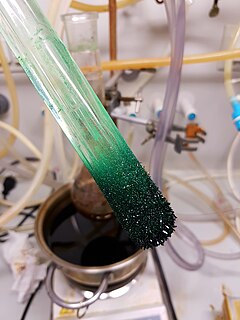 W
WSublimation is the transition of a substance directly from the solid to the gas state, without passing through the liquid state. Sublimation is an endothermic process that occurs at temperatures and pressures below a substance's triple point in its phase diagram, which corresponds to the lowest pressure at which the substance can exist as a liquid. The reverse process of sublimation is deposition or desublimation, in which a substance passes directly from a gas to a solid phase. Sublimation has also been used as a generic term to describe a solid-to-gas transition (sublimation) followed by a gas-to-solid transition (deposition). While vaporization from liquid to gas occurs as evaporation from the surface if it occurs below the boiling point of the liquid, and as boiling with formation of bubbles in the interior of the liquid if it occurs at the boiling point, there is no such distinction for the solid-to-gas transition which always occurs as sublimation from the surface.
 W
WSublimation apparatus is equipment, commonly laboratory glassware, for purification of compounds by selective sublimation. In principle, the operation resembles purification by distillation, except that the products do not pass through a liquid phase.
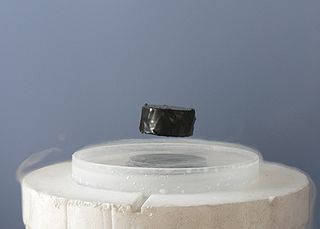 W
WSuperconductivity is a set of physical properties observed in certain materials where electrical resistance vanishes and magnetic flux fields are expelled from the material. Any material exhibiting these properties is a superconductor. Unlike an ordinary metallic conductor, whose resistance decreases gradually as its temperature is lowered even down to near absolute zero, a superconductor has a characteristic critical temperature below which the resistance drops abruptly to zero. An electric current through a loop of superconducting wire can persist indefinitely with no power source.
 W
WA symplectite is a material texture: a micrometre-scale or submicrometre-scale intergrowth of two or more crystals. Symplectites form from the breakdown of unstable phases, and may be composed of minerals, ceramics, or metals. Fundamentally, their formation is the result of slow grain-boundary diffusion relative to interface propagation rate.
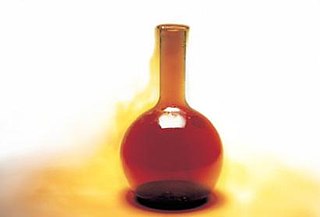 W
WVaporization of an element or compound is a phase transition from the liquid phase to vapor. There are two types of vaporization: evaporation and boiling. Evaporation is a surface phenomenon, whereas boiling is a bulk phenomenon.
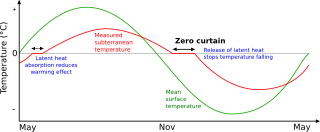 W
WThe zero-curtain effect occurs in cold environments where the phase transition of water to ice is slowed due to latent heat release. The effect is notably found in arctic and alpine permafrost sediments, and occurs where the air temperature falls below 0°C followed by a rapid drop in soil temperature.